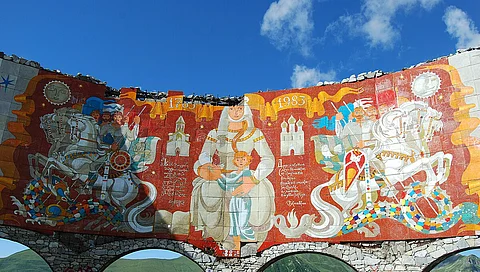
- Destinations
- Experiences
- Stay
- What's new
- Celebrating People
- Responsible Tourism
- CampaignsCampaigns
- Subscribe
- Buy Now

Across Georgia, from the bustling streets of Tbilisi to smaller towns and cities, street art forms a vibrant spread that weaves together the country’s rich cultural heritage with contemporary expression. This dynamic scene is marked by a fascinating interplay between modern murals and historic Soviet-era mosaics, both of which contribute to the unique visual identity of Georgian urban spaces.
Modern street art thrives in creative hubs like Fabrika in Tbilisi but also spills into unexpected corners of the country, where artists use walls as platforms for social and political commentary. Through a diverse range of techniques—including graffiti, stencils, and large-scale murals—these artworks tackle themes of cultural identity, social justice, and personal freedom. They invite onlookers to engage with Georgia’s evolving story, reflecting the hopes, challenges, and resilience of its people.
Soviet mosaics served as a durable form of propaganda, far more enduring than posters or murals. Crafted from tiles and embedded into permanent structures like buildings and bus stops, they resisted fading and damage, ensuring lasting visibility. Rising in popularity during the 1970s, mosaics brought colour and individuality to the otherwise uniform Soviet architecture.
While the Soviet era is remembered with pain and repression—particularly in Georgia—many people have come to appreciate these mosaics for their artistic merit and historical significance, viewing them as valuable cultural artefacts despite their complex legacy. Today, the remnants of Soviet mosaics stand as poignant reminders of the past, their intricate designs etched into the fabric of cities and towns alike.
The Tbilisi Mural Fest is a lively celebration of street art that showcases the city’s rich cultural heritage. This annual festival features striking murals, including a poignant tribute to Maro Makashvili, a Georgian national hero who courageously resisted the Soviet Red Army in 1921.
Georgian mosaics often explore a variety of themes deeply rooted in the country’s culture and history. Some celebrate Georgia’s role in the Soviet-era tea industry, while others portray important historical figures or showcase traditional clothing. In the western regions, near the Black Sea, many mosaics feature fish or Poseidon motifs, reflecting both the coastal landscape and Georgia’s ancient connections to Greek history and mythology. Unlike typical Soviet propaganda, many 20th-century Georgian mosaics stand out for their focus on national identity and folklore, offering a rich and diverse visual experience that is culturally meaningful, historically significant, and often delightfully imaginative.
Georgia is home to a vibrant mural scene that stretches across the country, with its capital, Tbilisi, serving as the creative heart. The city’s streets burst with colourful artworks that offer both social commentary and a rich celebration of Georgian culture. Among the standout contributors is the Niko Movement, a project focused on rejuvenating urban spaces through art, alongside notable individual artists like Musya.
One of Musya Qeburia’s most striking murals, Girl Swimming in Plastic, is located near the Be Chill mural and depicts a girl swimming amidst jellyfish and plastic bags, delivering a powerful environmental message. The Niko Movement has also left its mark with bold murals such as DANTE’s polar bear, which enrich Tbilisi’s urban landscape. Their work extends beyond the capital, with murals found in other Georgian cities that capture everyday life with vivid storytelling.
Be sure to also explore the Expo Georgia mosaics, a remarkable collection of Soviet-era artworks situated at the Expo Georgia exhibition centre in Tbilisi. Created between 1961 and 1963, these mosaics celebrate technological and scientific achievements and remain a striking feature of the former Exhibition of Achievements of National Economy.
For those eager to explore further, Fabrika is a must-visit. Once a Soviet sewing factory, it has been transformed into a bustling cultural hub adorned with colourful murals and street art that embody the vibrant spirit of modern Georgia.
Several mosaic murals have been carefully restored and relocated to Zugdidi, transforming them into a new cultural attraction. Originally from the village of Rukhi, these murals—including Lady in Red, Summer in Samegrelo, and Musicians—are remarkable examples of 20th-century public art. The restoration project, part of the EU4Dialogue initiative and supported by the European Union and UNDP, brought together Georgian and French experts alongside local youth.
This restoration forms part of a wider movement to preserve Georgia’s Soviet-era art, complemented by initiatives like the publication of a detailed map of Soviet mosaics and the book Mosaics of the Soviet Period. These efforts are vital, as urban development and privatisation threaten to erase these unique artworks from the country’s visual landscape.
If you’re interested in learning more about Georgia’s Soviet-era mosaics, Nini Palavandishvili’s book Mosaics of the Soviet Period in Georgia offers a comprehensive exploration of these artworks. Additionally, Geoair, a local Georgian art collective, has created a detailed map highlighting the locations of Soviet mosaics across the country.
They have also published Tbilisi: It’s Complicated, a book that invites readers to engage thoughtfully with the city’s Russian and Soviet architectural legacy, encouraging a deeper understanding of its complex history and cultural layers.
